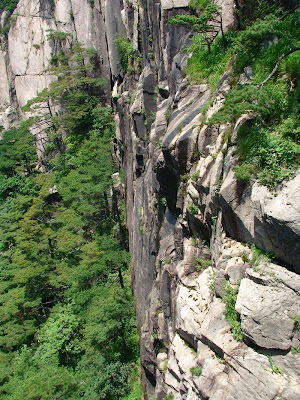From Shanghai Zhang took Eileen and I westward to one of the great sights of natural China. Huangshan, the yellow mountain, has been a tourist attraction for centuries. The influence of its remarkable scenery on Chinese art is palpable; the best way I can describe the summit of Huangshan is to say that it is every Chinese landscape painting you have ever seen come to life - towering sheer cliffs, magnificent pines growing improbably out of vertical rock faces, the lot.
Thousands of Chinese tourists still visit Huangshan, either climbing the mountain or, like us, making the long ascent by cable car. Of course we went there in search of nature as well as scenery, but so overwhelming is the ever-changing landscape at the top of the mountain that I have decided, for this entry, to concentrate on the scenery alone.
Here, then, are views of Mount Huangshan, taken on the remarkable single day, last July 1, that we spent there, from the first cable car ascent in the morning over ten kilometers of increasingly steep, paved and stepped trails to our descent by another cable car, on a different route, in the late afternoon. I present them without comment except to note that the tall rocky spire with a pine perched, seemingly impossibly, at its tip is known (for obvious reasons) as the Paintbrush.
Thousands of Chinese tourists still visit Huangshan, either climbing the mountain or, like us, making the long ascent by cable car. Of course we went there in search of nature as well as scenery, but so overwhelming is the ever-changing landscape at the top of the mountain that I have decided, for this entry, to concentrate on the scenery alone.
Here, then, are views of Mount Huangshan, taken on the remarkable single day, last July 1, that we spent there, from the first cable car ascent in the morning over ten kilometers of increasingly steep, paved and stepped trails to our descent by another cable car, on a different route, in the late afternoon. I present them without comment except to note that the tall rocky spire with a pine perched, seemingly impossibly, at its tip is known (for obvious reasons) as the Paintbrush.


































































